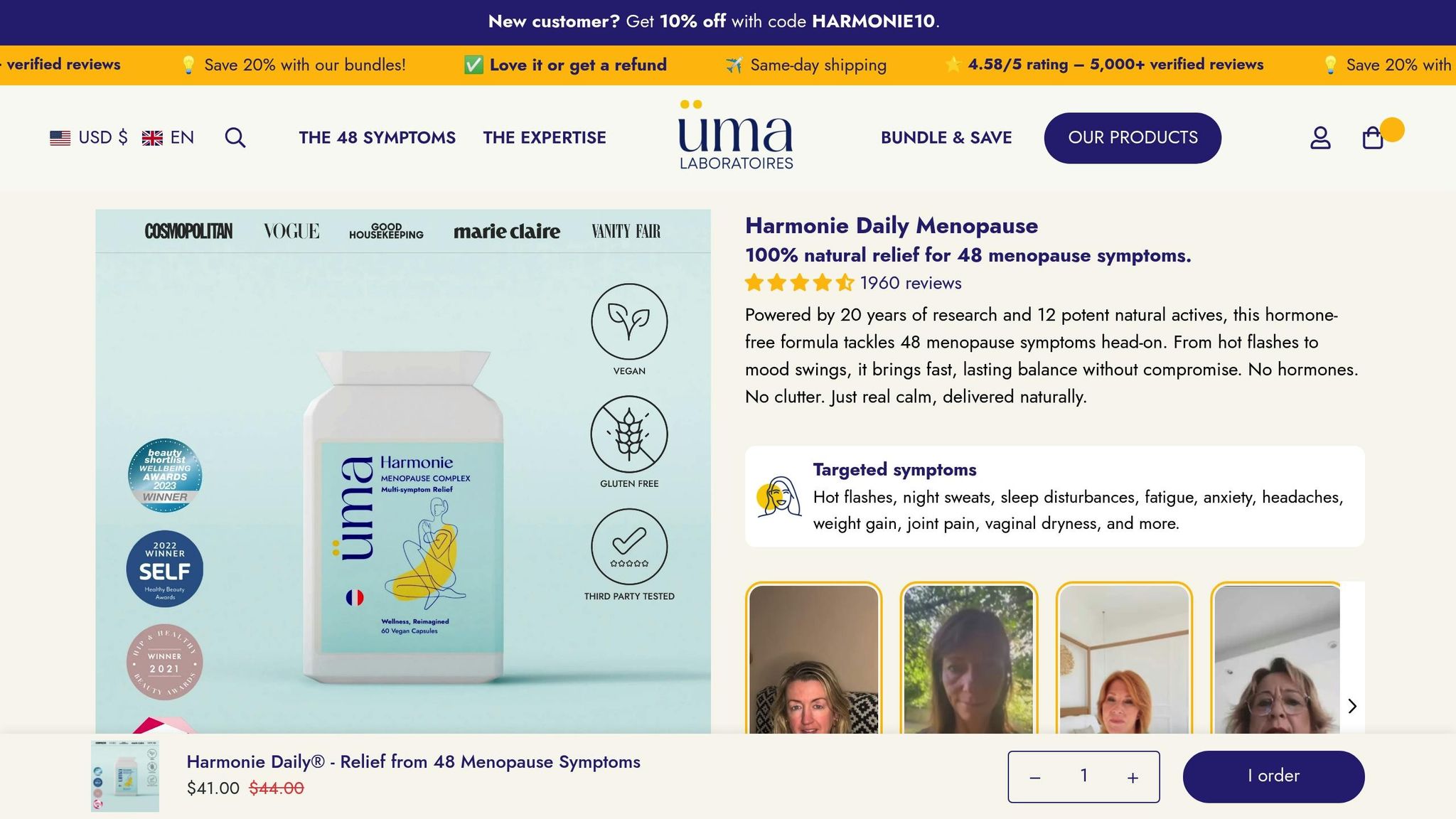Journaling can transform your menopause experience. In just 10 to 15 minutes per day, you can track your symptoms, better understand your emotions, and discover what works best for you. Here are the key benefits:
- Manage stress and emotions: Free your mind and reduce anxiety linked to hormonal shifts.
- Track your symptoms: Identify your triggers and spot patterns to better anticipate changes.
- Improve medical communication: A clear history helps your doctor offer tailored solutions.
- Build self-awareness: Understand your needs and celebrate your progress.
Paper or digital?
Choose the format that suits you:
| Format | Benefits | Drawbacks |
|---|---|---|
| Paper | Touch Experience, No Screen | No backup, less convenient |
| Digital | Accessible everywhere, automatic backup | Eye strain, technology dependency |
Start today: Record your feelings, your symptoms, and your positive moments. In just a few weeks, this practice can lower your stress and help you enjoy this transition even more.
My Menopause Journey: Symptoms, Emotions, and Tips for Better Living Through This Stage
The benefits of journaling during menopause
Journaling, or daily writing, can play a key role during menopause, offering tangible benefits backed by scientific research. For example, a study published in the Journal of Women & Aging shows that expressive writing helps reduce psychological distress and improves women's mood.
Managing Emotions and Stress
Facing the emotional upheavals often linked to menopause, writing regularly helps release tension in a personal, intimate space. The hormonal fluctuations during this period can heighten stress and anxiety, making this practice even more valuable.
"By making journaling a regular habit, you create a safe, private space for your emotions to come out, free from outside judgment." – Australian Menopause Centre Team
To get the most out of it, it's best to write freely without holding yourself back, and to pick a quiet moment to refocus on yourself.
Symptom tracking. Pattern identification.
Journaling is not just about expressing your emotions. It also tracks physical symptoms and uncovers recurring patterns. By regularly documenting bodily changes and lifestyle habits, you collect valuable data to better understand your body and enrich your conversations with health professionals.
Did you know that 53% of women feel they aren’t getting the right support during this time? A well-kept journal becomes a valuable tool to clarify your needs and improve your communication with your doctor.
Development of Self-Awareness
Beyond tracking symptoms, this practice builds self-awareness. With one in five women taking more than a year to receive an accurate diagnosis, it's crucial to take time to jot down your feelings and observations.
"Journaling during menopause serves as a powerful tool. It helps women process their experiences, track their symptoms, and gain clarity amid change." – Bristol Menopause
By writing regularly, you can:
- Explore your thoughts and emotions deeply
- Identify your specific needs
- Develop strategies to better handle challenges
- Recognize and celebrate your progress, even the smallest.
This habit turns a challenging transition into a chance to get to know yourself better and grow. Writing becomes a powerful ally to help you navigate menopause with ease.
Start your menopause journal
Now that you know the benefits of journaling, let's get down to business: how to get started. It all begins by choosing the method and structure that work best for you.
Paper or digital format
The choice between a paper or digital journal depends entirely on your preferences. Here’s a comparison table to help you decide:
| Format | Benefits | Drawbacks |
|---|---|---|
| Paper | • Tactile and personal experience • No screens • Creative freedom |
• No backup • Less convenient to bring along • Hard to modify |
| Digital | • Always accessible • Automatic backup • Simplified organization |
• Visual fatigue • Privacy risks • Dependence on technology |
When I want to slow down, connect with my thoughts, and enjoy a screen-free moment, I grab my paper journal. The act of writing by hand helps me process my emotions deeply.
- Mariam Gigashvili, wellness expert
No matter which format you choose, the key is to set up your journal in a way that gives you the most benefit.
Essential sections of the journal
To make your journal useful and relevant, consider including these key sections in your daily entries:
- Date and time: To track the progress of your experiences over time.
- Description of symptoms : Note the physical or emotional sensations.
- Intensity: Rate your symptoms on a scale of 1 to 10.
- Context and activities: Identify the associated situations or events.
- Duration: Tell us how long the symptoms lasted.
Also add spaces dedicated to personal reflections:
- Emotional Notes: A place to explore your emotions and track your mood swings.
- Positive Moments: Take time to note moments of gratitude or small victories.
- Wellness Plan: Track your self-care goals and assess your progress.
With a structure in place, it's time to turn this practice into a regular habit.
Create a writing routine
Making journaling a lasting habit doesn't take much time. A 2018 study showed that just 15 minutes of positive writing three times a week are enough to ease anxiety and boost your resilience.
Some tips for maintaining regularity:
- Settle into a quiet, comfortable spot away from distractions.
- Start by writing freely for 5 to 10 minutes.
- Set reminders on your phone so you don't forget.
The key is there are no rules for journaling. You can use guiding questions to set a framework, or simply write down your feelings, dreams, and ambitions. You can even draw.
- Michelle Howard, yoga teacher
Remember, consistency matters more than perfection. Every session, even a short one, contributes to your well-being.
Writing Methods and Topics
Here are some practical ideas to boost your menopause journal and turn it into a truly useful tool.
Questions for tracking symptoms
For accurate daily tracking, ask yourself these questions:
| Category | Questions to Ask Yourself |
|---|---|
| Physical Symptoms | • What symptoms did I feel today? • What time did they appear? • What was their intensity (from 1 to 10)? |
| Trigger Factors | • What did I consume before they appeared (foods, drinks)? • What activities did I do? What was my stress level? |
| Solutions | • What helped ease your symptoms? • How long did they last? • What strategies have proven effective? |
Express your emotions through writing
The journal goes beyond tracking symptoms. It can also serve as a space to explore your emotions.
Begin with simple sentences like: "Today, I feel..." or "What struck me most today is...". Then, dive deeper with these questions:
- What situation triggered this emotion?
- How did this emotion show itself physically?
- How intense was it?
Highlight the positive moments
To balance your thoughts, add positive and uplifting elements to your journal.
Daily gratitude journal :
- Note three moments of happiness or satisfaction you experienced during the day.
- Describe a situation where you felt strength or resilience.
- Celebrate a small personal victory, even if it seems minor.
Exercise to embrace a positive perspective :
- What did I learn about myself today?
- Have I noticed any progress in how I manage my symptoms?
- What personal quality did I strengthen thanks to this stage in my life?
The key is to cultivate a regular routine that helps you better understand your journey and navigate this phase with more ease.
Combine journaling with other health practices
Journaling is a valuable tool for tracking and understanding your symptoms. It becomes even more effective when you pair it with other health practices. Here are some ideas to make the most of this combination.
Follow the results with Harmonie Daily®

A structured journal can help you record precise observations. Here are some elements to include:
| Aspect to watch | Points to note |
|---|---|
| Physical Symptoms | • Intensity of hot flashes (scale 1-10) • Sleep quality • Daily energy level |
| Taking the supplement | • Dosage schedule • Quantity taken • Regularity |
| Observed changes | • Symptom improvement • Onset of action • Lasting effects |
Combine these insights with your relaxation routines for a more complete and personalized approach.
Journaling and stress management
Journaling can be a great complement to relaxation techniques. Here are some ideas on how to incorporate them:
- Take 5 minutes to write before a meditation session.
- Take note of your body sensations after a yoga session.
- Rate your stress level on a scale of 1 to 10 before and after these practices.
These written reflections will help you better understand how these activities affect your well-being.
Tracking daily habits
Your journal can also help you analyze your habits and their impact on your symptoms. Here are a few things to track:
Food and hydration
- Which foods seem to worsen or improve your symptoms?
- How much water do you drink every day?
- Note down the details of your meals and snacks.
Physical Activity
- What types of exercise do you practice? (yoga, walking, swimming, etc.)
- How long and at what intensity?
- Notice improvements in your symptoms within just 24 to 48 hours.
Sleep
- What time do you go to bed, and when do you wake up?
- Rate your sleep quality on a scale of 1 to 10.
- What factors influence your rest (temperature, stress, physical activity)?
By combining journaling, relaxation, and habit tracking, you create a personalized system to better manage your menopause symptoms. This method lets you identify what works best for you and adjust your routines accordingly.
Conclusion: Start your menopause journal today
Menopause journaling can be a valuable ally to help you navigate this period with greater ease. In April 2022, research showed that keeping a journal offers tangible benefits: clearer thinking, reduced stress, and calmer emotion management.
Take 5 to 10 minutes every day to write—ideally in the morning when you wake up or in the evening before bed. Remember, it’s consistency that counts, not the duration.
Some pointers to get started:
- How are you feeling today?
- Which symptoms have you noticed?
- What has brought you well-being?
You can also track your natural care routine in your journal. This helps you see the connection between your observations and the improvements you feel. For example, studies show that keeping a journal regularly can reduce perceived stress by 28%. During menopause, when hormonal fluctuations often increase stress, these benefits can be especially valuable.
To take it a step further, create a dedicated section for your natural care products (like Harmonie Daily®). Observe the changes in your symptoms and overall well-being. This approach helps you pinpoint what works best for you.
Don't forget: your journal is your personal space, free from judgment. There's no "right" way to write in it. What matters is finding a routine that suits you. Over time, you'll learn to understand your needs better and boost your confidence in managing this transition.
Why wait? Just a few minutes can turn your feelings into a valuable tool for well-being. Start today!
FAQs
How can journaling help me better manage my menopause symptoms?
Journaling: Your Ally for a Better Menopause
Keeping a journal can be a valuable way to understand and manage your menopause symptoms better. By recording your feelings each day, you can spot trends, like when your symptoms intensify, and identify triggers such as your diet, stress, or sleep quality.
This habit also helps you gauge the impact of changes to your lifestyle or routine. It makes it easier to share precise details about your symptoms and how they evolve with your healthcare professionals. In short, it's a simple approach tailored to your daily self-care needs.
What are the benefits of using a digital journal over a paper one to track menopause changes?
Track your menopause with a digital or paper journal
Choosing a digital journal to track your menopause offers undeniable practical advantages. It’s accessible in a snap from your smartphone, tablet, or computer, allowing you to jot down your observations anytime. Plus, these digital tools often feature handy extras like reminders, charts to visualize your symptom changes, and search options to quickly find exactly what you need.
However, if you prefer a more personal, hands-on approach, a paper journal might be the better fit. The feel of the paper and the act of writing can make the experience more intimate and soothing.
The key is to choose the option that feels most natural and comfortable to help you understand your body and its changes over time.
How can I easily incorporate journaling into my daily routine during menopause?
Integrate journaling into your everyday routine
To make journaling a habit, start by choosing a specific time of day that works for you, such as the morning to kickstart your day or the evening to relax. Grab a notebook you love and a pen that feels great to use – this will make the experience more enjoyable and motivating.
Let your thoughts flow in your writing: jot down your emotions, your feelings, or even the standout moments of your day. If you run out of inspiration, try simple prompts like:
- What made me smile today?
- What small steps can I take to feel better this week?
During menopause, journaling can become a valuable ally. This practice helps you not only explore your emotions but also understand the physical and psychological changes you experience. With a bit of consistency, this ritual will become your personal moment—perfect for reconnecting with yourself and boosting your well-being.






